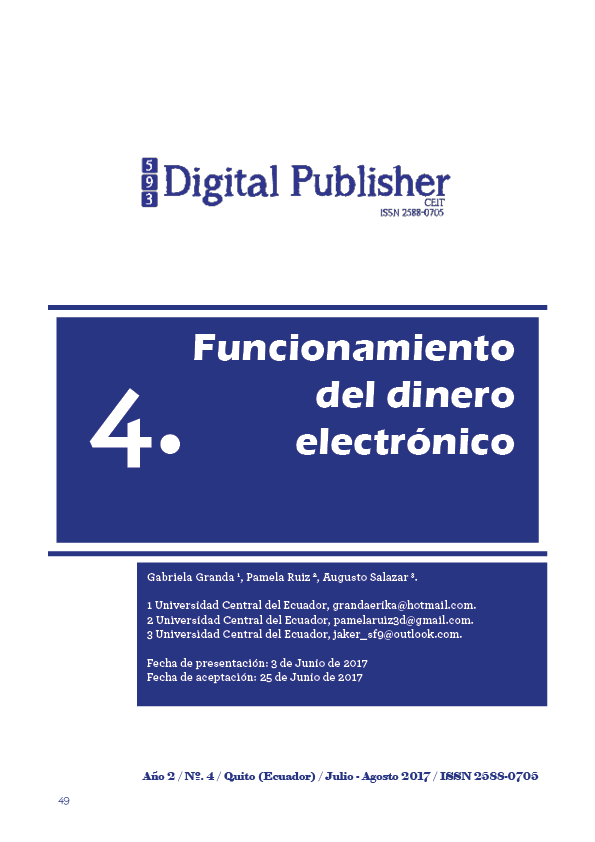How the money works electronic
Main Article Content
Abstract
Technological advances have allowed electronic money to acquire a constant growth since its appearance in the late twentieth century. It is part of a great innovation in terms of payment services
that agilitates and provides financial inclusion knowing that it has excellent advantages compared to other means of payment is a very reliable and fast, this new system is very good for the economy of the country . It will also provide the opportunity for citizens to make financial transactions, such as withdrawing money, transfers, payments, among others; with a lower cost than what is charged in the traditional financial sector and without additional cost for transactions. The implementation of a new easy access payment tool for Ecuadorians, which is constituted, is a worthy subject to analyze what is proposed in the following essay.
Downloads
Article Details
1. Derechos de autor
Las obras que se publican en 593 Digital Publisher CEIT están sujetas a los siguientes términos:
1.1. 593 Digital Publisher CEIT, conserva los derechos patrimoniales (copyright) de las obras publicadas, favorece y permite la reutilización de las mismas bajo la licencia Licencia Creative Commons 4.0 de Reconocimiento-NoComercial-CompartirIgual 4.0, por lo cual se pueden copiar, usar, difundir, transmitir y exponer públicamente, siempre que:
1.1.a. Se cite la autoría y fuente original de su publicación (revista, editorial, URL).
1.1.b. No se usen para fines comerciales u onerosos.
1.1.c. Se mencione la existencia y especificaciones de esta licencia de uso.
References
AA., A. D. (2012). The Foundations of Financial. The World Bank.
Aghion, P. a. (1997). A Theory of Trickle-Down Growth and Development. Review of Economics Studies.
Ali, R. B. (2014). Innovations in payment. Bank of England Quarterly.
Aportela, F. (s.f.). “Effects of Financial Access on Savings by Low-Income People”. 2014: MIT.
Ashraf, N. A. (2010). Remittances and the Problem of Control. Mimeo.
Ashraf, N. K. (2010). Female Empowerment: Further Evidence. World Development. 28.
Beck, T. D.-K. (2010). Financial Institutions and Markets. World Bank Economic.
Carbo S., G. E. (2005). Financial Exclusion. Palgrave MacMillan.
Demirguc-Kunt, A. a. (2012). Measuring Financial Inclusion: The Global. Washington DC.
Ecuador, B. C. (2014). Resolución Administrativa BCE-118-2014.
Mundial, B. (2012). Financial Inclusion Data Global Index.
Telégrafo, E. (2014). Cooperativas tienen más de 4,6 millones de clientes.

